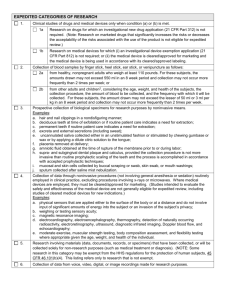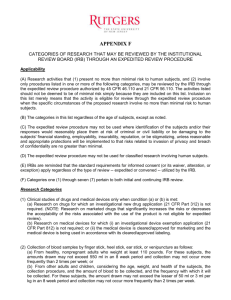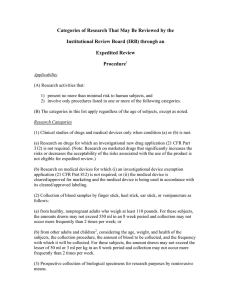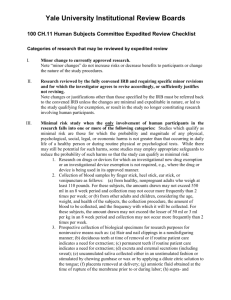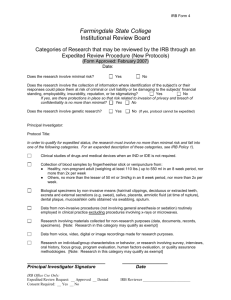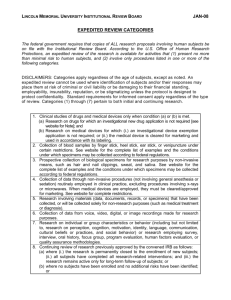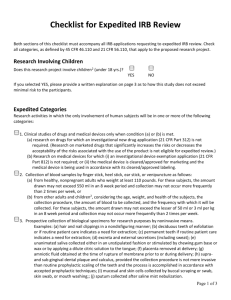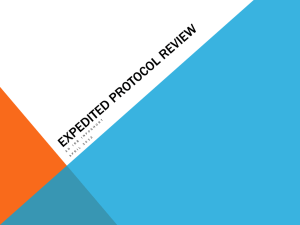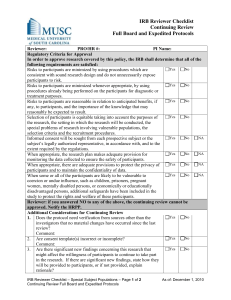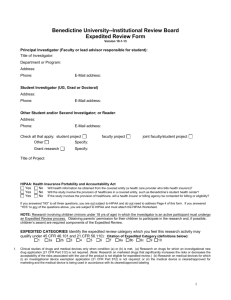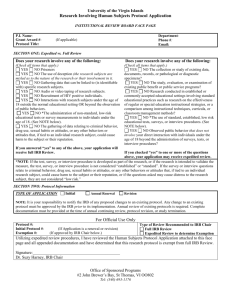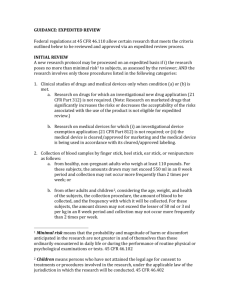Expedited Research Categories
advertisement
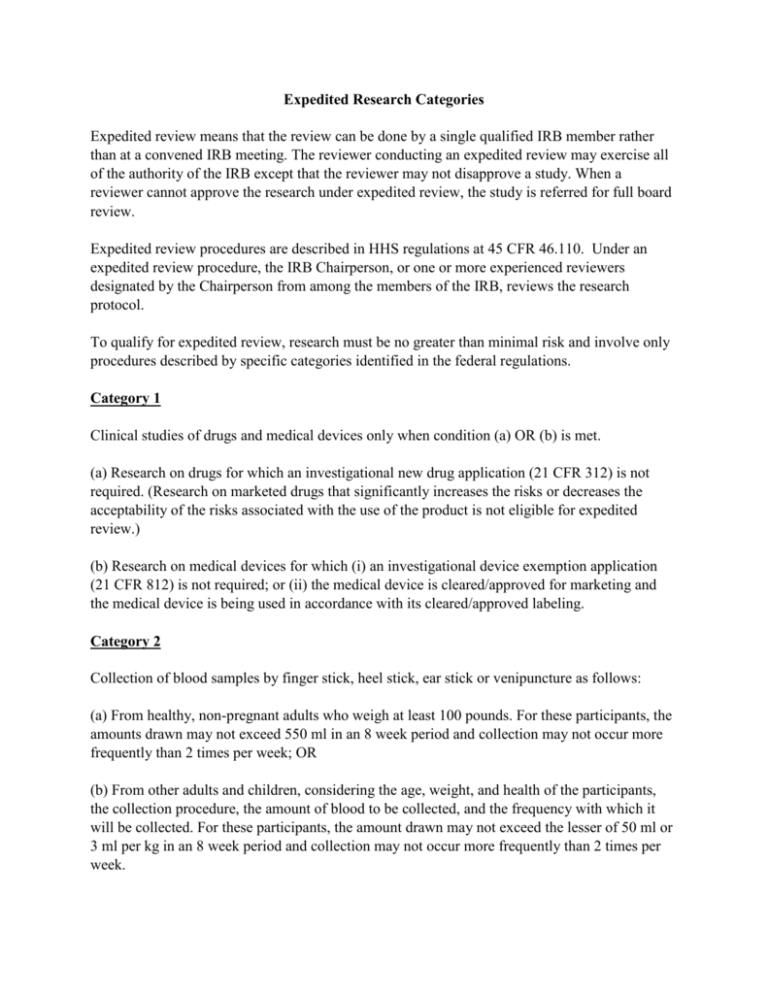
Expedited Research Categories Expedited review means that the review can be done by a single qualified IRB member rather than at a convened IRB meeting. The reviewer conducting an expedited review may exercise all of the authority of the IRB except that the reviewer may not disapprove a study. When a reviewer cannot approve the research under expedited review, the study is referred for full board review. Expedited review procedures are described in HHS regulations at 45 CFR 46.110. Under an expedited review procedure, the IRB Chairperson, or one or more experienced reviewers designated by the Chairperson from among the members of the IRB, reviews the research protocol. To qualify for expedited review, research must be no greater than minimal risk and involve only procedures described by specific categories identified in the federal regulations. Category 1 Clinical studies of drugs and medical devices only when condition (a) OR (b) is met. (a) Research on drugs for which an investigational new drug application (21 CFR 312) is not required. (Research on marketed drugs that significantly increases the risks or decreases the acceptability of the risks associated with the use of the product is not eligible for expedited review.) (b) Research on medical devices for which (i) an investigational device exemption application (21 CFR 812) is not required; or (ii) the medical device is cleared/approved for marketing and the medical device is being used in accordance with its cleared/approved labeling. Category 2 Collection of blood samples by finger stick, heel stick, ear stick or venipuncture as follows: (a) From healthy, non-pregnant adults who weigh at least 100 pounds. For these participants, the amounts drawn may not exceed 550 ml in an 8 week period and collection may not occur more frequently than 2 times per week; OR (b) From other adults and children, considering the age, weight, and health of the participants, the collection procedure, the amount of blood to be collected, and the frequency with which it will be collected. For these participants, the amount drawn may not exceed the lesser of 50 ml or 3 ml per kg in an 8 week period and collection may not occur more frequently than 2 times per week. Category 3 Prospective collection of biological specimens for research purposes by non-invasive means. Examples include: •Hair and nail clippings in a non-disfiguring manner; •Deciduous teeth at time of exfoliation or if routine patient care indicates a need for extraction; •Permanent teeth if routine patient care indicates a need for extraction; •Excreta and external secretions (including sweat); •Uncannulated saliva collected either in an unstimulated fashion or stimulated by chewing gumbase or wax or by applying a dilute citric solution to the tongue; •Placenta removal at delivery; •Amniotic fluid obtained at the time of rupture of the membrane prior to or during labor; •Supra- and subgingival dental plaque and calculus, provided the collection procedure is not more invasive than routine prophylactic scaling of the teeth and the process is accomplished in accordance with accepted prophylactic techniques; •Mucosal and skin cells collected by buccal scraping or swab, skin swab, or mouth washings; •Sputum collected after saline mist nebulization Note: On October 4, 2010, OHRP clarified that it agrees with the FDA’s position that the following procedures are considered noninvasive: •Vaginal swabs that do not go beyond the cervical os; •Rectal swabs that do not go beyond the rectum; and •Nasal swabs that do not go beyond the nares. Category 4 Collection of data through non-invasive procedures (not involving general anesthesia or sedation) routinely employed in clinical practice, excluding procedures involving x-rays or microwaves. Where medical devices are employed, they must be cleared/approved for marketing. Studies intended to evaluate the safety and effectiveness of the medical device are not generally eligible for expedited review, including studies of cleared medical devices for new indications. Examples include: •Physical sensors that are applied either to the surface of the body or at a distance and do not involve input of significant amounts of energy into the participant or an invasion of the participant's privacy; •Weighing or testing sensory acuity; •Magnetic resonance imaging; •Electrocardiography, electroencephalography, thermography, detection of naturally occurring radioactivity, electroretinography, ultrasound, diagnostic infrared imaging, doppler blood flow, and echocardiography; •Moderate exercise, muscular strength testing, body composition assessment, and flexibility testing where appropriate given the age, weight, and health of the individual. Category 5 Research involving materials (data, documents, records, or specimens) that have been collected or will be collected solely for non-research purposes (such as medical treatment or diagnosis). NOTE: •Some research using only retrospective data may qualify for exempt category 4. •This category is applicable to research involving the use of data obtained from medical charts when the investigator wishes to collect both retrospective and prospective data. •This category includes materials that are collected for either non-research or research purposes, provided that any materials collected for research were not collected for the currently proposed research. •The phrase "...or will be collected solely for non-research purposes" pertains to the origin of the materials. For example, blood samples that were collected for a clinical test. Category 6 Collection of data from voice, video, digital, image recordings made for research purposes. Category 7 Research on individual or group characteristics or behavior (including but not limited to research on perception, cognition, motivation, identity, language, communication, cultural beliefs or practices, and social behavior) or research employing survey, interview, oral history, focus group, program evaluation, human factors evaluation, or quality assurance methodologies. NOTE: Some research utilizing these procedures may qualify for exempt category 2. Category 8 Continuing review of research previously approved by the convened IRB as follows: (a) where (i) the research is permanently closed to the enrollment of new subjects; (ii) all subjects have completed all research-related interventions and (iii) the research remains active only for long-term follow-up of subjects; OR (b) where no subjects have been enrolled and no additional risks have been identified; OR (c) where the remaining research activities are limited to data analysis. NOTE: Closure of enrollment only has to apply to the local site, not to all sites. Category 9 Continuing review of research, not conducted under an investigational new drug application or investigational device exemption where categories two (2) through eight (8) do not apply but the IRB has determined and documented at a convened meeting that the research involves no greater than minimal risk and no additional risks have been identified.
